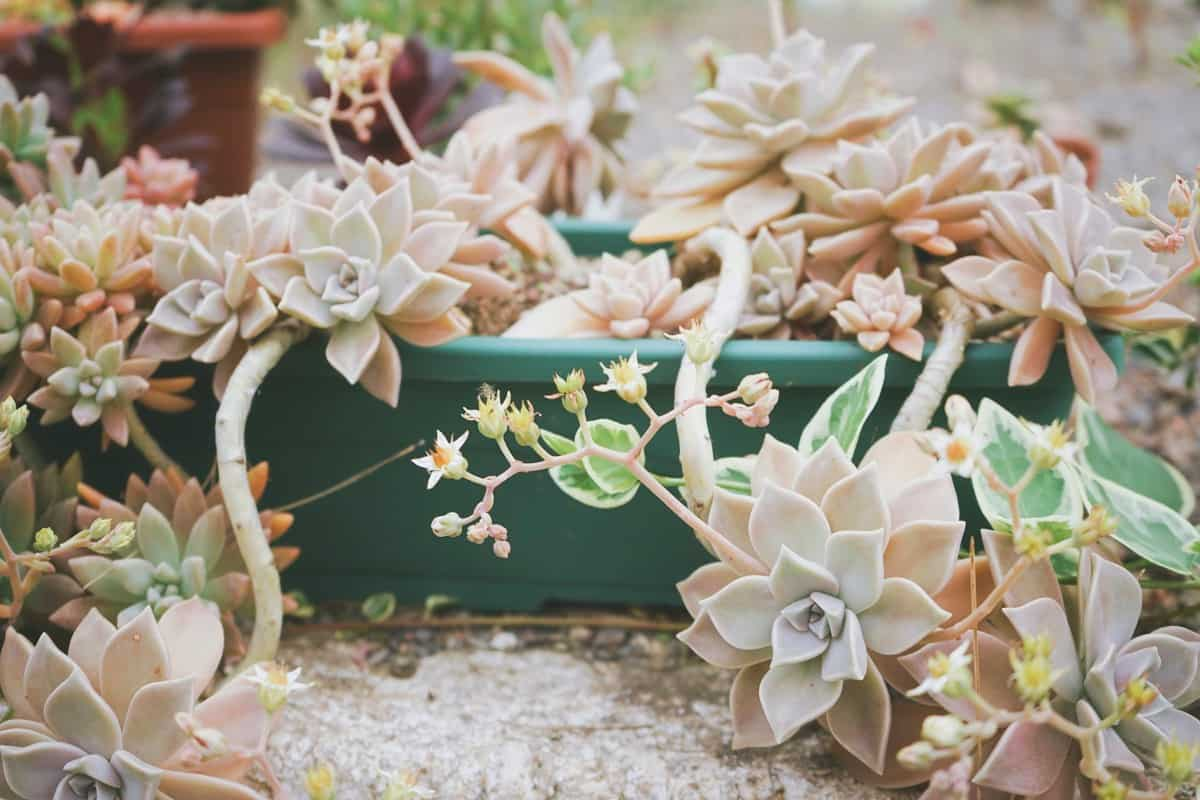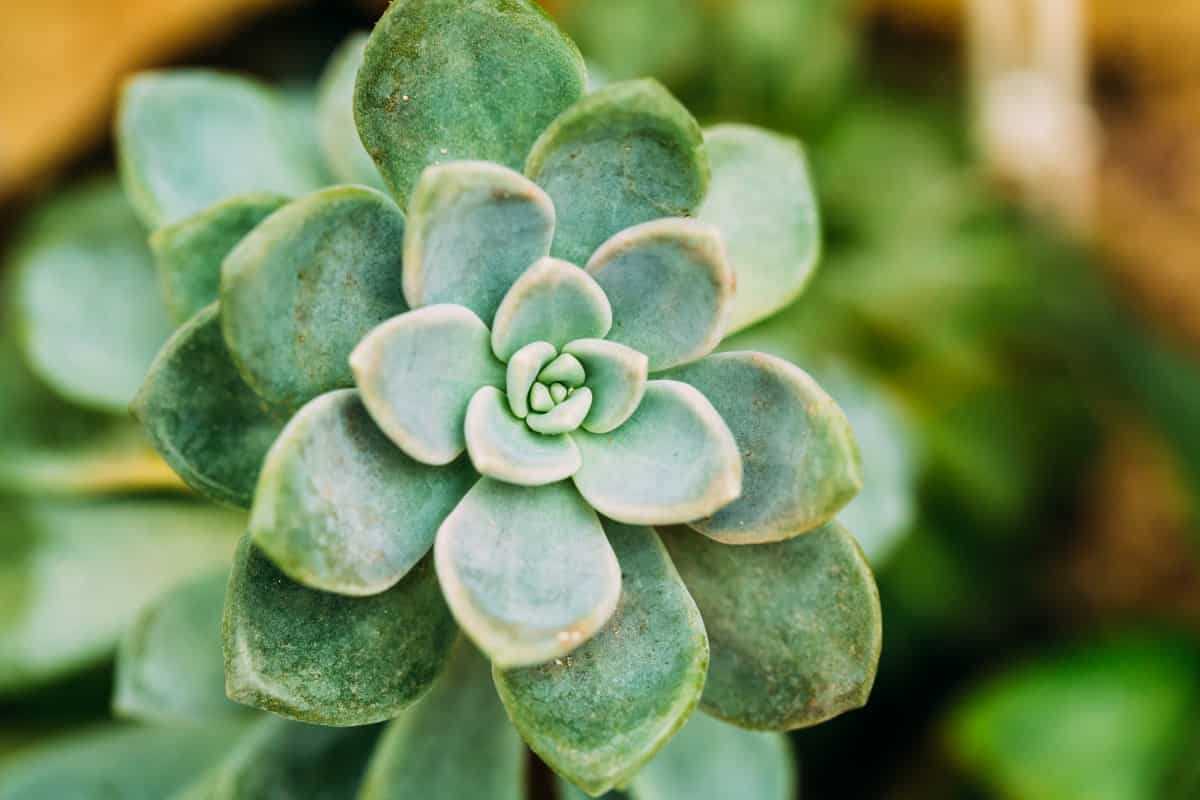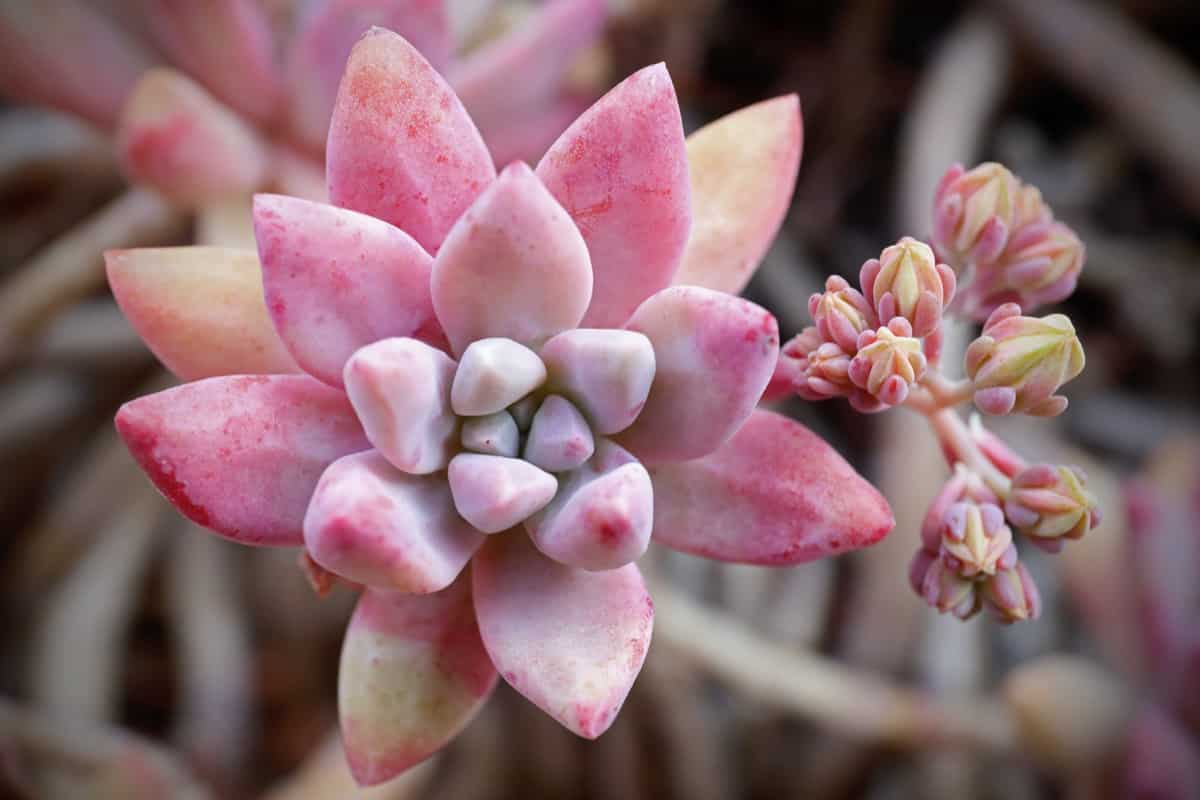The Ghost plant (Graptopetalum paraguayense) is a succulent plant native to the Mexican state of Tamaulipas and is normally grown as a houseplant or garden plant. Can you grow a Ghost plant indoors? Ghost plants offer a wide range of benefits for both indoor and outdoor gardeners. These unique succulents add beauty to any space and require minimal care and maintenance. Ghost plants are incredibly low-maintenance, perfect for busy or novice gardeners. Let’s check out more information about ghost plant care below.

Choosing the Right Location for Your Ghost Plant
Choosing the right location for your Ghost Plant is crucial to its health and growth. This beautiful succulent thrives in bright, indirect sunlight, so finding a spot with the right light is important. Place your Ghost Plant near a window that receives plenty of natural light, but protect it from direct sun exposure, as this can cause leaf burn. In addition to light, temperature is an important factor in choosing a location for your Ghost Plant. When it comes to indoor placement, choose an area with good humidity levels.
Information about Ghost Plant
| Common Name | Ghost plant, mother-of-pearl plant |
| Botanical Name | Graptopetalum paraguayense |
| Plant Type | Perennial, succulent |
| Sun Exposure | Full to partial sun |
| Soil Type | Sandy, light potting mix |
| Bloom Time | Spring |
Soil Requirements and Potting Mix for Ghost Plants
Regarding the soil needs of your Ghost plants, it’s important to remember that these succulents thrive in well-draining soil. An ideal potting mix for Ghost plants should consist of gritty materials such as perlite and organic matter. This creates a light and porous medium that provides good drainage while retaining enough moisture for the plant’s roots. You can also add some sand into the mix to further enhance drainage. A ratio of 1 part grit to 2 parts organic matter is generally recommended, but feel free to adjust based on your specific conditions. Additionally, avoid using fertilized soils, as Ghost plants don’t require high levels of nutrients.
Providing Proper Lighting for Ghost Plants
One of the key factors in successfully caring for Ghost plants is providing them with the proper lighting conditions. Does the Ghost plant need full sun? These succulents thrive in bright, indirect sunlight. Placing them near a south-facing window or where they can receive at least six hours of sunlight daily is ideal.
In case you missed it: Pink Panther Plant Care: Best Fertilizer, Pruning, and Propagation

Using fluorescent grow lights or LED lights designed specifically for indoor gardening can provide the necessary light spectrum for their growth. Find a suitable spot and let it acclimate before considering any adjustments. Ensuring your Ghost plant receives adequate light is crucial for its health and growth.
Watering Techniques and Frequency for Ghost Plants
These succulents have adapted to survive in arid conditions, so they don’t require frequent watering like other houseplants. Overwatering the Ghost plant can lead to root rot and the demise of your Ghost plant. The key to watering Ghost plants is to balance keeping the soil moist and allowing it to dry out completely between waterings.
It may need more frequent watering during hot summer or if your Ghost plant is exposed to direct sunlight. However, reducing watering frequency would help when growth slows during winter or cooler months. Remember that these plants are drought-tolerant and can handle periods of neglect better than overwatering. Proper watering techniques involve finding the right balance between moisture and drying out periods for your Ghost plant.
Fertilizing Ghost Plants: Tips and Recommendations
These succulents have specific nutrient requirements to help them thrive and maintain their vibrant colors. Here are some tips and recommendations to keep in mind when fertilizing your Ghost plants. It’s important to choose the right fertilizer for your Ghost plants. Look for a balanced, water-soluble fertilizer specifically formulated for cacti and succulents. This type of fertilizer will provide the necessary nutrients without overwhelming the plant.
Ghost plants prefer a weak dilution because they are sensitive to excess nutrients. Over-fertilization can lead to burnt leaves or even root damage. It’s generally advised not to fertilize during winter dormancy as the plant’s growth slows considerably.
Pruning and Propagating Ghost Plants
Pruning helps maintain a compact and neat appearance, while propagation allows you to expand your collection or share plants with friends. Ghost plants are forgiving and can handle a bit of trimming. Start by inspecting the plant for any dead or damaged leaves. Using clean scissors or shears, carefully remove these leaves at their base. This improves the overall aesthetics and prevents potential diseases from spreading.
You can easily propagate them to create new plants. To do this, gently twist off one of the bottom rosettes from its stem. Allow the cutting to dry for a few days until calloused before placing it in well-draining soil.
Another method of propagating Ghost plants is through leaf cuttings. Pluck a healthy leaf from the rosette and let it dry for several days until calloused. Then, place the leaf on moistened soil and wait patiently for tiny new roots to appear. Remember that patience is key when propagating Ghost plants, as they may take time to establish themselves fully. With proper care and attention, you’ll soon have a thriving collection of Ghost plants.
In case you missed it: Oyster Plant Care: Moses-in-the-cradle Fertilizer, Trimming, and Indoor Care

Dealing With Common Pests and Diseases in Ghost Plants
One common pest that can affect Ghost plants is mealybugs. These tiny insects feed on the sap, causing stunted growth and yellowing leaves. You can use alcohol to remove them manually or spray the affected areas with organic insecticidal soap. Another common issue is root rot caused by overwatering or poor drainage. To prevent this, ensure your Ghost plant is planted in well-draining soil and avoid overwatering it. If you suspect root rot, gently remove the affected parts of the Ghost plant and repot it in fresh soil.
Ghost plants are also prone to fungal infections such as black spot disease. These can be treated with fungicides specifically formulated for succulents or by removing the infected leaves. Regularly inspecting your Ghost plant for signs of pests or diseases and taking swift action, you can ensure its health and longevity when necessary.
How to Fix Leggy Ghost Plant: Treatment and Remedies
A leggy Ghost plant is usually a sign of not getting enough light. These plants love bright, indirect sunlight, so it’s time for a change if yours sits in a shady corner. One solution is to move your Ghost plant to a brighter location. Find a spot near a sunny window where it can soak up those rays. If natural light isn’t an option, you can use grow lights to provide the necessary brightness.
Another remedy for legginess is pruning. Trim back the long stems of your Ghost plant to encourage new growth. Use clean scissors or shears and cut just above leaf nodes or branching points. If you want your Ghost plant to become bushier and more compact, try propagating some new plants from the cuttings you took during pruning. Place the cut sections in well-draining soil or water until roots develop. Remember, prevention is key to preventing legginess in Ghost plants. Ensure they get enough light from the start and avoid overwatering, which can cause weak growth.
Seasonal Ghost Plant Care: Winter Dormancy and Summer Growth
During the winter months, Ghost plants go into a period of dormancy. This is completely normal and part of their natural growth cycle. To care for your Ghost plant during winter dormancy, it’s important to reduce watering frequency. Since the plant is not actively growing, it doesn’t require as much water.
Another important aspect of seasonal care is providing adequate light for your Ghost plant. During the winter months, when daylight hours are shorter, it may be necessary to move your plant closer to a window or provide supplemental grow lights if you’re growing them indoors. As spring approaches and temperatures rise, you’ll notice new growth emerging from your Ghost plant. Remember that these plants love bright light but can also tolerate some shade.
In case you missed it: Purslane Plant Care: Pruning, Controlling Pests and Diseases

Conclusion
The Ghost plant is an evergreen succulent plant that can be grown as a garden or indoor plant in warmer regions but is more often grown as a potted houseplant. These succulents have adapted to survive in arid environments, meaning they can withstand long periods without water. Like many other houseplants, Ghost plants help improve air quality by filtering environmental toxins and releasing oxygen.
- Feed Your Flock for Less: Top 10 Tips to Save on Chicken Feed
- Ultimate Guide to Ossabaw Island Hog: Breeding, Raising, Diet, and Care
- Hatching Answers: The Top 10 Reasons Your Chickens Aren’t Laying Eggs
- Eggs and Economics: Breaking Down the Cost of Raising Backyard Chickens
- Defend Your Greens: Proven Methods to Keep Iguanas Out of Your Garden
- Ultimate Guide to Cinnamon Queen Chicken: A Comprehensive Guide for Beginners
- Ultimate Guide to California Tan Chicken: Breeding, Raising, Diet, Egg-Production and Care
- Ultimate Guide to Marsh Daisy Chicken: Breeding, Raising, Diet, and Care
- 10 Types of Chicken Farming Businesses You Can Start for Profits